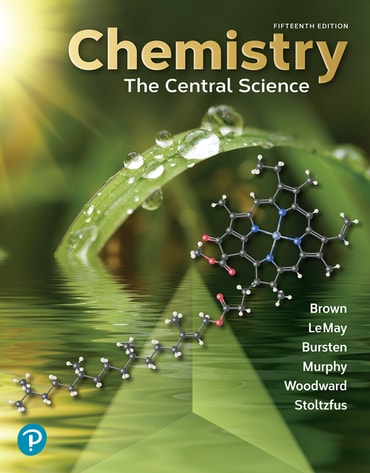
- Ch.1 - Introduction: Matter, Energy, and Measurement140
- Ch.2 - Atoms, Molecules, and Ions192
- Ch.3 - Chemical Reactions and Reaction Stoichiometry172
- Ch.4 - Reactions in Aqueous Solution142
- Ch.5 - Thermochemistry110
- Ch.6 - Electronic Structure of Atoms120
- Ch.7 - Periodic Properties of the Elements109
- Ch.8 - Basic Concepts of Chemical Bonding107
- Ch.9 - Molecular Geometry and Bonding Theories132
- Ch.10 - Gases132
- Ch.11 - Liquids and Intermolecular Forces74
- Ch.12 - Solids and Modern Materials87
- Ch.13 - Properties of Solutions85
- Ch.14 - Chemical Kinetics121
- Ch.15 - Chemical Equilibrium63
- Ch.16 - Acid-Base Equilibria104
- Ch.17 - Additional Aspects of Aqueous Equilibria105
- Ch.18 - Chemistry of the Environment52
- Ch.19 - Chemical Thermodynamics99
- Ch.20 - Electrochemistry103
- Ch.21 - Nuclear Chemistry64
- Ch.22 - Chemistry of the Nonmetals6
- Ch.23 - Transition Metals and Coordination Chemistry18
- Ch.24 - The Chemistry of Life: Organic and Biological Chemistry10
Chapter 20, Problem 22c
Hydrazine 1N2H42 and dinitrogen tetroxide 1N2O42 form a self-igniting mixture that has been used as a rocket propellant. The reaction products are N2 and H2O. (c) Which substance serves as the reducing agent and which as the oxidizing agent?
 Verified Solution
Verified SolutionVideo transcript
Indicate whether the following balanced equations involve oxidation–reduction. If they do, identify the elements that undergo changes in oxidation number. (b) NaI(aq) + 3 HOCl(aq) → NaIO3(aq) + 3 HCl(aq)
Indicate whether the following balanced equations involve oxidation–reduction. If they do, identify the elements that undergo changes in oxidation number. (a) 2 AgNO3(aq) + CoCl2(aq) → 2 AgCl(s) + Co(NO3)2(aq)
At 900 °C, titanium tetrachloride vapor reacts with molten magnesium metal to form solid titanium metal and molten magnesium chloride. (a) Write a balanced equation for this reaction.
Complete and balance the following half-reactions. In each case, indicate whether the half-reaction is an oxidation or a reduction. (b) TiO21s2 ¡ Ti2+1aq2 (acidic solution)
Complete and balance the following half-reactions in basic solution. In each case, indicate whether the half-reaction is an oxidation or a reduction.
a. OH−(𝑎𝑞)⟶O2(𝑔)
b. SO32−(𝑎𝑞)⟶SO42−(𝑎𝑞)
c. N2(𝑔)⟶NH3(𝑔)
d. HO2−(𝑎𝑞)⟶OH−(𝑎𝑞)
Complete and balance the following half-reactions. In each case, indicate whether the half-reaction is an oxidation or a reduction. (f) SO32-1aq2 ¡ SO42-1aq2 (basic solution)
